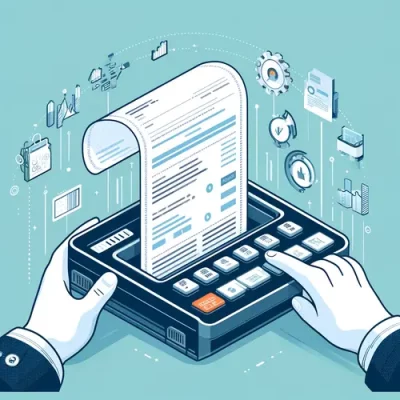Invoices are widely used for products and services when being traded for money. It is set as proof because it contains vital financial information regarding the transaction.
With many transactions of products and services happening around an enterprise, it will be difficult to check for accountants, bookkeepers, and finance officers on every invoice.
In this blog, we’ll talk about how invoice capture works how to check and extract invoice data from PDF and what are the benefits of having automated invoice capture processes.
What is Invoice Capture?
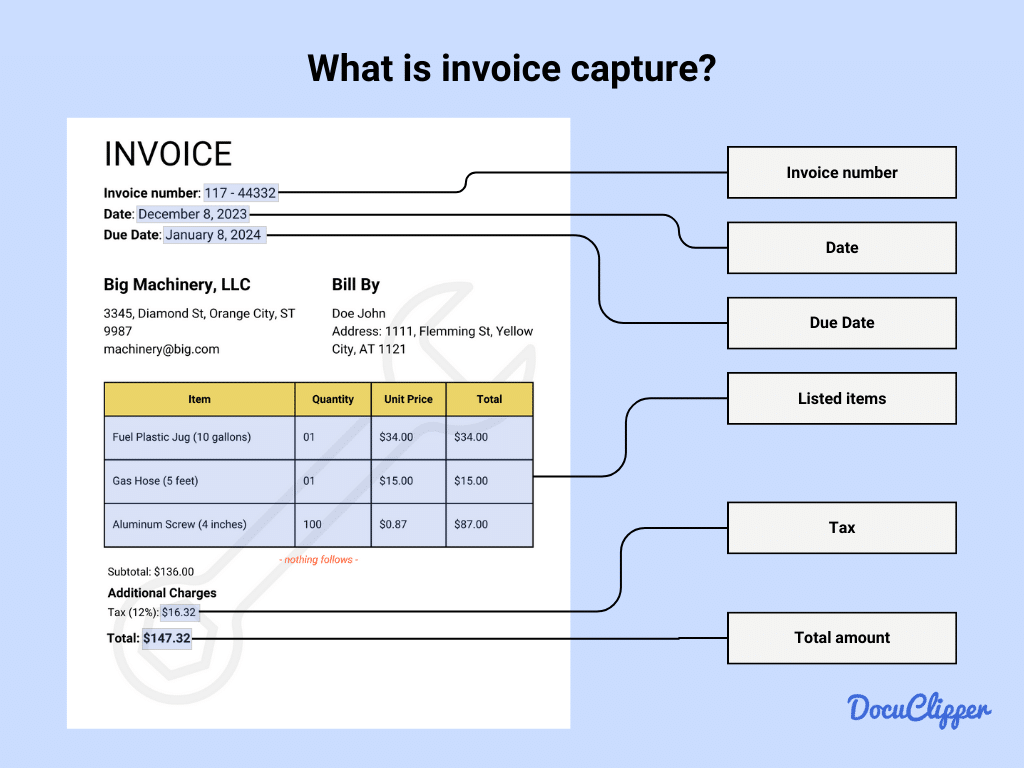
Invoice capture is the process of capturing necessary information from an invoice using technology for invoice automation. This information can be dates, amounts, line items, invoice numbers, currencies, and many more.
Invoice capture is one of the essential tools to streamline and simplify invoice management and invoice digitalization processes and improve the overall financial data quality.
Benefits of Implementing Invoice Capture
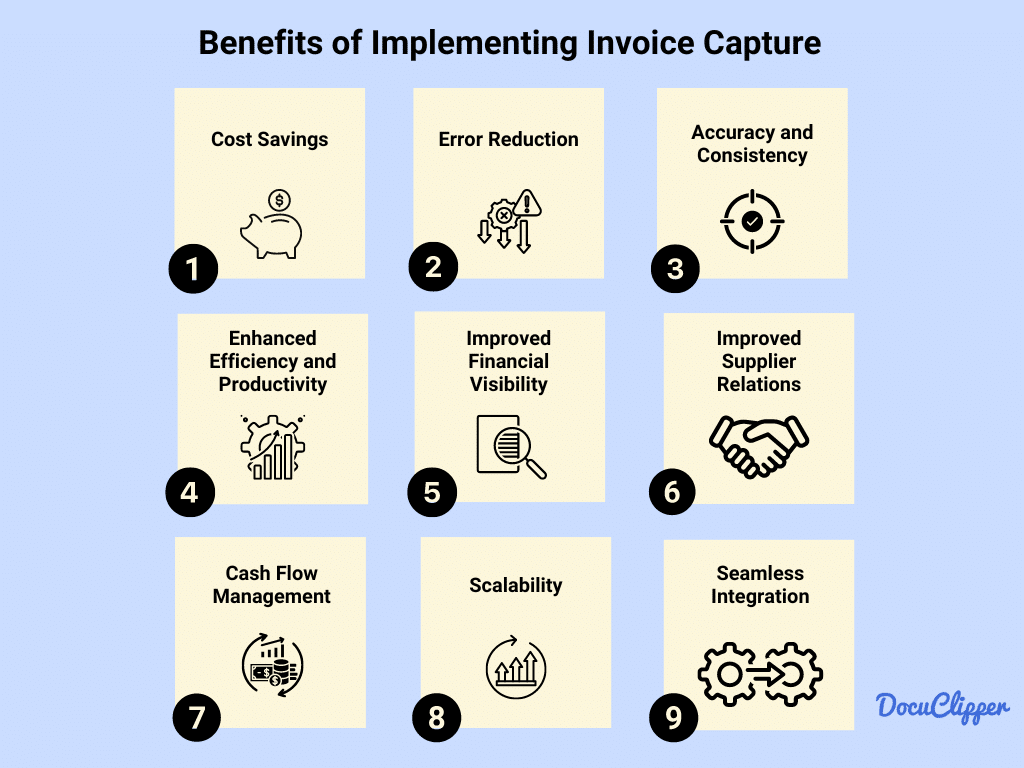
There are many benefits in implementing invoice capture as many accounting firms are slowly adapting to automated data entry processes for assessing financial information.
- Cost Savings: Automation significantly reduces costs per invoice from about $16 to as low as $3, according to the Institute of Finance & Management (IOFM).
- Error Reduction: Automated systems like invoice data capture decrease data entry errors by up to 34%.
- Accuracy and Consistency: Optical Character Recognition (OCR) technology achieves 97% accuracy when processing invoices, ensuring uniform outputs across various formats.
- Enhanced Efficiency and Productivity: Streamlining accounts payable processes cut invoice processing times by up to 80%, also reducing AP team stress.
- Improved Financial Visibility: Digitalization of all invoice data allows comprehensive viewing within a unified system.
- Improved Supplier Relations: 25% of people on an AP team mentioned that a slow turnover rate spoils client relations. A fast invoice OCR data capture process certainly avoids this.
- Cash Flow Management: Financial tools within invoice processing software provide insights into cash flow dynamics.
- Scalability: Modern systems can extract data from documents in seconds, far outpacing manual invoice processing.
- Seamless Integration: API systems in software like DocuClipper facilitate direct connections to accounting systems such as QuickBooks, Sage, and Xero, minimizing transfer errors
How Does Invoice Capture Work?
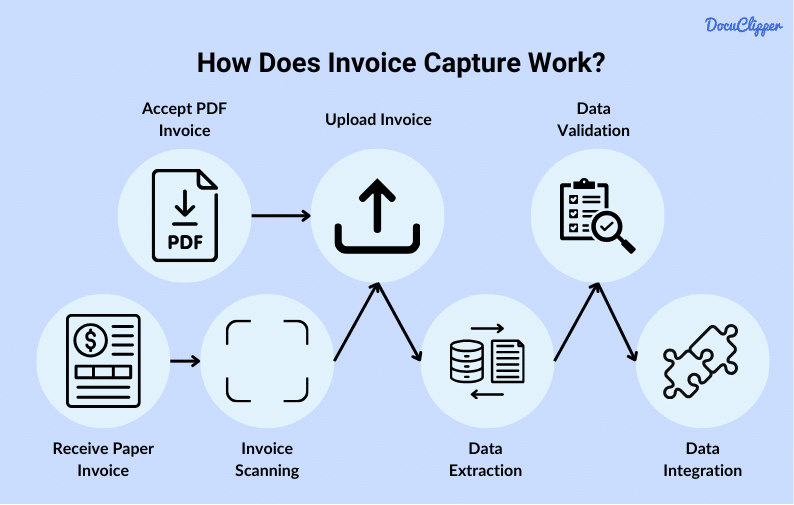
Invoice capture streamlines financial record-keeping by automating the entry and processing of invoice data. Here’s how it typically works:
- Centralize Invoice Receiving: Businesses receive invoices either as PDFs via email or as paper documents. Each format requires a different initial handling method.
- Uploading and Scanning: PDF invoices are directly uploaded to the invoice capture software. Paper invoices, however, must first be scanned to create a digital copy.
- Data Extraction: The invoice capture software then extracts information from the invoice. This includes the vendor’s name, address, invoice number, the total amount due, line items, dates, and possibly terms of payment.
- Data Validation: After extraction, the software performs invoice reconciliation. This step ensures that the extracted information matches what’s on the invoice, reducing the likelihood of errors. Common ways are 2-way matching, 3-way matching, or 4-way matching.
- Data Integration: Finally, the validated invoice data is transferred to an accounting system or a spreadsheet. This integration allows for streamlined financial management, where payment tracking and general bookkeeping are simplified.
This process allows you to streamline your invoice processing and keep your invoices organized so you don’t miss any invoices and payments are made in due time.
How to Capture Data from Invoices
Once you have decided that you need to capture invoice data with the right software in place, here are the steps to start it launching.
Step 1. Open Software: Launch DocuClipper and navigate to the “Invoices and Receipts” section.
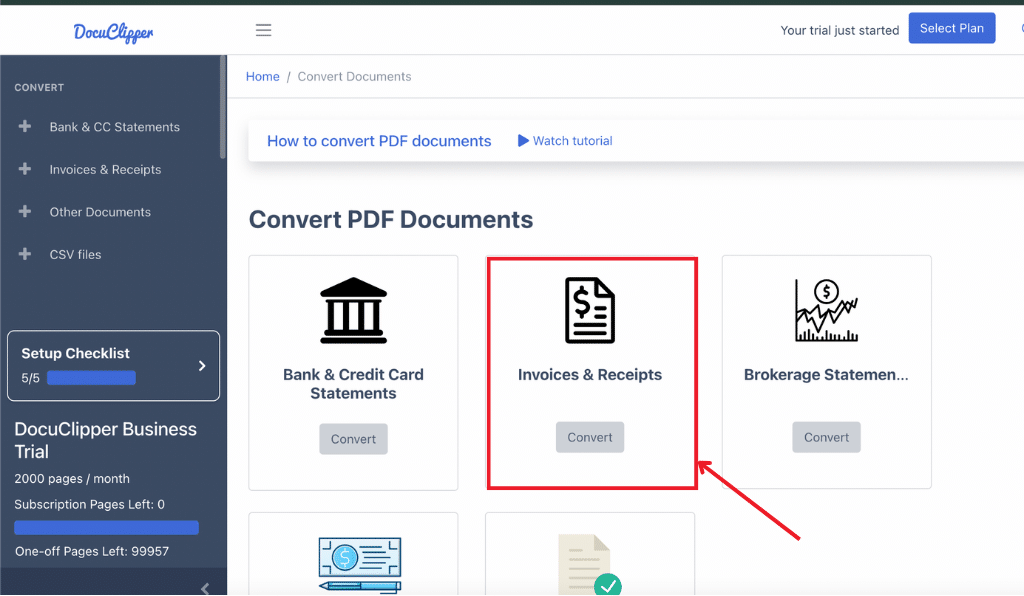
Step 2. Upload Files: Drag or upload your invoice files into the software. Assign a name to this job for easy tracking.
Step 3. Initiate OCR: Use DocuClipper’s Optical Character Recognition (OCR) to read the invoice text on scanned invoices. This technology allows for the processing of multiple invoices simultaneously. Click on “import” to begin.
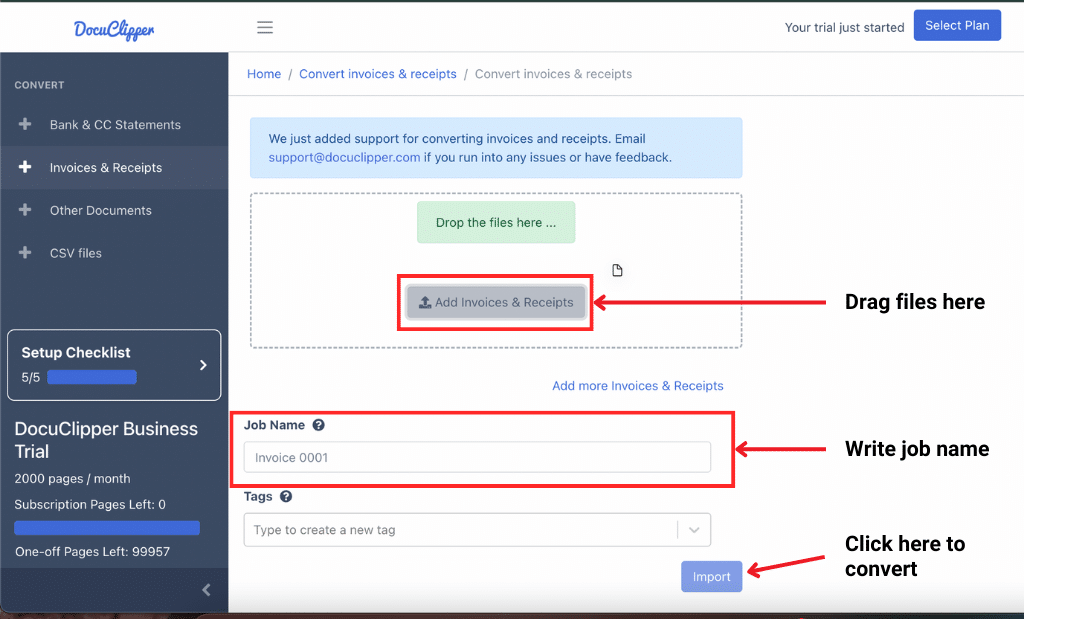
Step 4. Invoice Data Extraction: DocuClipper will automatically extract details such as item descriptions, subtotal, tax, total, and dates, from the invoices.
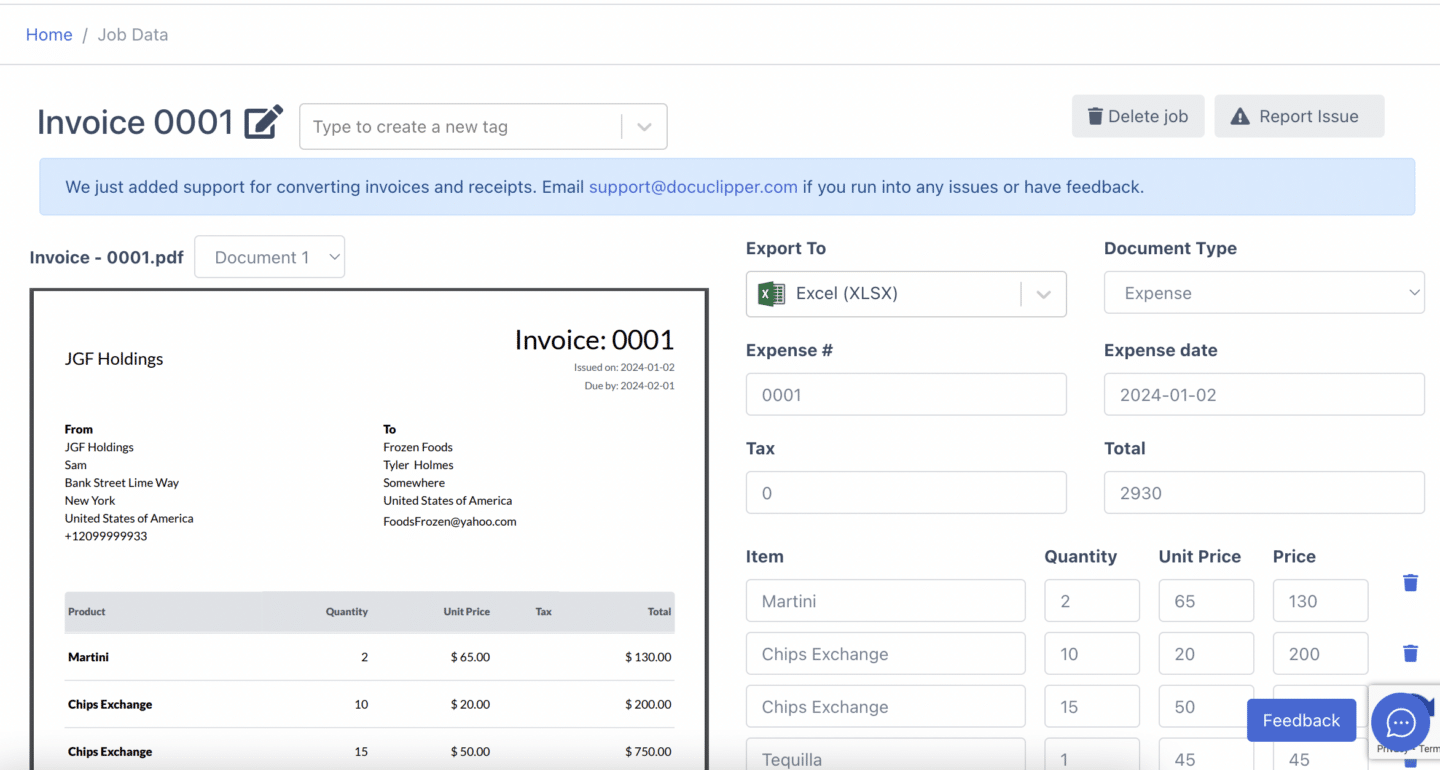
Step 5a. Preview and Export: Review a preview of the extracted data, including taxes, dates, and items. Decide the format for the output file—Excel, CSV, or QBO. Choose the desired format and click “Export” to complete the process.
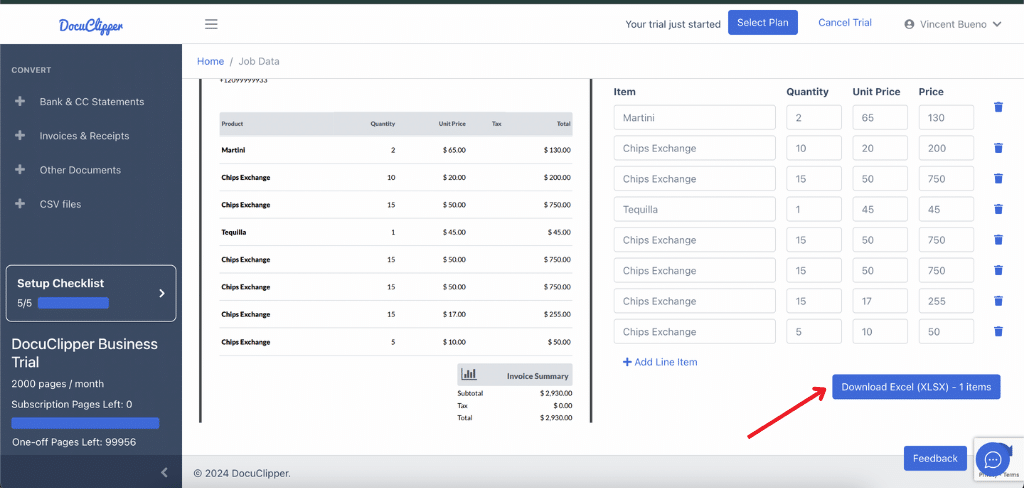
Step 5b. Import Invoices Into QuickBooks: Furthermore you can import extracted invoices into QuickBooks by connecting your QB account to DocuClipper.
Best Practices for Improving Invoice Capture Accuracy
Here are 5 best practices for improving invoice capture accuracy:
- Upload Original PDFs: When the vendor, supplier, or shop provides a PDF invoice, use that one as it contains the best quality and original data
- Use High-Quality Scanners: Invest in high-quality scanners to ensure clear images, reducing the risk of OCR errors when converting paper invoices to digital formats.
- OCR Preprocessing: When using scanned data, preprocessing like cleaning, cropping, and tilting the invoice has a lower chance of affecting OCR accuracy.
- Select Specialized Invoice OCR Software: Unlike generic OCR software, Invoice OCR software such as DocuClipper uses specialized algorithms to extract data from invoices with the highest accuracy.
- Implement Double-Check Systems: Set up verification protocols where key invoice data is double-checked either by automated systems or manually by staff to catch and correct errors.
- Train Your Team: Regularly train employees on the latest invoice processing technologies and error-checking procedures to maintain high levels of invoice accuracy in data capture.
Overall, the Invoice OCR accuracy depends on several factors, practicing these steps can help you stay away and avoid any variables that might give rise to potential errors in your invoice capture process,
Best Invoice Capture Software
Once you decide to go automated in processing invoices, here are some of the best invoice capture software available:
- DocuClipper: DocuClipper is a specialized web-based tool designed for scanning invoices into structured data formats such as Excel, CSV, and QBO with a remarkable accuracy rate of 97%.
- AutoEntry: AutoEntry is a specialized data automation tool tailored for streamlining accounting processes by automating the extraction and publication of data to major accounting software platforms. It can also scan invoices for accounting use.
- DextPrepare: Dext Prepare is a specialized platform designed to enhance the productivity and profitability of accountants and businesses. It offers robust tools that prepare, sort, and automatically publish invoices and receipts.
- Docsumo: Docsumo is a leading Intelligent Document Processing (IDP) solution for financial docs. Initially launched to automate invoice processing.
- Nanonets: Nanonets is an AI-driven invoice parser automation platform tailored for streamlining complex business processes. It uses AI to extract and convert valuable information from invoices and receipts into practical insights.
Conclusion
Invoice capture opens up accounting practices by automating data extraction from invoices, and streamlining financial management.
It ensures critical details are accurately and swiftly captured, supporting thorough financial analysis and reporting. Adopting automated invoice capture allows businesses to enhance efficiency, reduce costs, and improve accuracy across financial operations,
FAQs about Invoice Capture
Here are some frequently asked questions about invoice capture:
How do I capture information from an invoice?
To capture information from an invoice, utilize specialized software equipped with Optical Character Recognition (OCR) technology. This software scans both digital and paper invoices to extract key data automatically.
What is an invoice record?
An invoice record is a detailed document that captures all the transactional details between a seller and a buyer, such as dates, amounts, item descriptions, and other relevant service or product details.
How do I capture an invoice in Excel?
To capture an invoice in Excel, first, convert the invoice into a digital format using OCR software. Then, import the extracted data into Excel either manually or through automated data integration tools.
What is billing information for invoice?
Billing information refers to the details of the party responsible for making the payment. This typically includes the name, address, and financial details like credit terms and payment methods.
What is the invoice process?
The invoice process includes several steps: issuing the invoice, confirming its receipt, checking and validating its contents, approving it for payment, and processing the payment to close the transaction.
What is the invoice data?
Invoice data includes critical information such as vendor and customer details, invoiced amounts, dates of transaction, and descriptions of the items or services provided.
What is the main purpose of an invoice?
The primary purpose of an invoice is to formally request payment for goods or services provided, serving as a documented claim for payment under agreed-upon terms.
What is the difference between invoice and billing invoice?
Generally, both terms refer to the same document. However, ‘billing invoice’ is sometimes specifically used to refer to documents related to periodic or recurring billing.
What is invoice filling?
Invoice filling is the process of completing an invoice with necessary data, such as item descriptions, quantities, prices, and total costs, ensuring all information is accurate and comprehensive for billing purposes.
